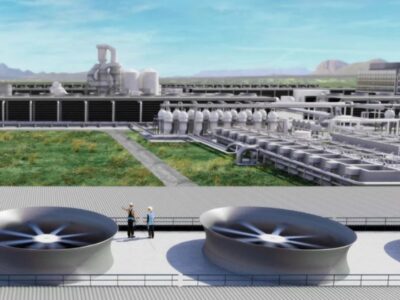(Bloomberg) —
JPMorgan Chase & Co. made waves in May when it announced it would purchase $200 million of carbon dioxide removal. Though it’s a relatively small investment for a bank JPMorgan’s size, it’s one of the largest corporate buys of carbon removal and could be a huge boon to the nascent industry to pull carbon out of the air.
Brian DiMarino, managing director and head of operational sustainability at JPMorgan, was the driving force behind the precedent-setting move in the financial services industry. The flow of money could help the industry scale up in the coming decades, which it will likely need to do if the world is to avoid catastrophic climate change.
Tech giants like Microsoft, Stripe and Spotify have led the way to date, but DiMarino is staking out JPMorgan’s claim as a financial leader. He’s making a name for himself within the carbon removal world not just for the amount of money he’s pumping into the field, but also for engaging with the community working on the nascent and unproven technology. That engagement earned him a spot on the stage at carbon removal startup Climework’s Direct Air Capture Summit in Zurich in June.
“We’re trying to lead in this space, and that’s intentional,” DiMarino said. But, he added, “over time, if we do our job right over time, we shouldn’t have to buy any more carbon removal.”
Beyond setting the bank’s carbon removal purchasing strategy, DiMarino’s team is responsible for measuring, mitigating and managing the firm’s operational emissions, from its branches to data centers.
Bloomberg Green spoke with DiMarino about carbon removal pathways he’s most excited about, other climate technologies JPMorgan is relying on as part of its decarbonization journey, as well as emissions associated with its investment and lending activities. The following conversation has been edited and condensed for clarity.
You’ve been at JPMorgan your entire career. How did you land in sustainability and end up running the carbon removal purchasing program?
I was in financials for most of my career at JPMorgan. I became the CFO of a big part of our commercial real estate portfolio. We started to get into the renewable energy space, did some power purchase agreements, and that was the first glint I saw of, “Hey, I could spend some more time in this space.” So I went to, at the time, our chief operating officer and said, “Hey, I think we could be doing more here.” The firm was starting to build up some work around [sustainability] anyway. It was a bit of the right place, right time.
We set up operational sustainability two years ago, [although] the firm’s been buying carbon offsets since 2007 in smaller formats. We’ll have just about 20 people [on the team] by the end of the year. In two years, we’ve really grown the team and the book of work, and I think it’s a testament to how much JPMorgan’s investing in this space across the firm.
Carbon removal is a largely untested industry far from mass commercialization. Why is investing in this field a priority for JPMorgan?
This should be a priority for everyone. We are in the midst of a climate crisis. We’re very focused on absolute emission reductions, but carbon offsets and carbon removal are a super important part of the puzzle because we have to manage what’s being emitted and already in the atmosphere today. These technologies are the way we’re able to do that, so we have to invest in them, help them scale and show that they’re valuable. One of the ways we do that is by putting the name of JPMorgan behind it and being willing to bet on this space.
As a buyer, how do you go about vetting carbon removal technology? Who do you lean on for technical and scientific guidance?
We have a really great partnership with [carbon management firm] Carbon Direct, so they’re one of the primary groups that we go to to look into this stuff. We do our own diligence, we do research, we read whatever third-party papers we can get. We try to understand the tech, then bring these things to Carbon Direct. We say, “Hey, listen, we feel good about this. Tell us what your thoughts are.” We’ll take their input. Sometimes we’ll even go to some other third parties like independent researchers.
What forms of carbon removal are you keeping an eye on besides direct air capture? Any other pathways that are promising and worth keeping an eye out on?
Everything’s important. As far as new tech and what’s coming, some of it’s not even tech. Some of it is sort of old tech, like enhanced rock weathering. Blue carbon is also interesting to us, [although] there’s less of an understanding about the leakage risks of ocean-based carbon removal. It’s very different from geologically-stored carbon, where we know it turns to rock, and we can drill core samples and see it.
What are the biggest obstacles to the carbon removal industry scaling?
One is demand. We regularly talk about a supply-constrained market, and that’s because these technologies are still trying to scale. But if the demand isn’t there today, investors don’t show up to finance these companies, and the companies never get to commercial scale. So we need demand and supply to tick up together, and I don’t think that we’re seeing as much demand as we need to see yet.
Capital is super important as well. Obviously if it doesn’t show up, you’re not going to scale these companies. The economy is shifting, and we’re seeing capital dry up a little. We don’t really have time for that from a climate perspective.
The other thing is infrastructure and human capital. This is an industrial-scale revolution we’re going through. This is not someone sitting on a computer typing code. This is steel and pipelines. It’s pumping bio-oil and sequestered carbon underground. You want to electrify the world. Where are all the electricians? You want to build offshore wind? Where are all the deep sea marine divers?
Besides carbon removal, what other climate tech solutions is JPMorgan relying or placing bets on in its decarbonization journey?
Decarbonizing commercial real estate is really hard. We want to make sure that we’re controlling things at a very specific level, so dispersed battery storage. If we can install batteries where we have solar panels, can we over-peak the panels, collect the excess energy and then use that overnight to keep the building off the grid longer? It’s not all lithium-ion. We’re looking at zinc bromide and redox batteries and stuff like that. Some of this stuff gets a little bit into left field, like there’s companies that are using agricultural waste. There’s 14 million tons of that stuff produced in the US every year, and it has no real use, and they can use that to produce renewable natural gas.
For certain industries, decarbonization challenges are obvious. For tech, it’s data centers, for example. What’s the biggest challenge when it comes to decarbonizing banking?
Data centers are actually a pretty big part of our operational footprint, [making up about] 35% of our operational emissions. They’re super intensive and quite honestly with things like AI and things getting more digitized, they’re only getting bigger.
Can you explain what financed emissions are, and what the challenge is for not just JPMorgan but the banking industry as a whole when it comes to addressing those?
Financed emissions is effectively an indirect emissions category that’s a measurement of the indirect impact of banking operations or banking underwriting and capital deployment in other industries. It’s relatively hard to decarbonize the world in general, and JPMorgan and other financial institutions support global economies.
The relationships that we have with companies that people may want to view as complicated are some of the ways that we’re able to influence the conversation. Those relationships are how we’re at the table and able to influence clients and other industries to do better. We have our own Paris Agreement-aligned commitments in six specific industries, some of the most emissions-intensive industries, to reduce our financed emissions in those industries.
We do that by working directly with those customers, not by running away from the conversation. Banks have a really critical role to play in decarbonizing the world. We’re connective tissue. We sit in the middle of the whole conversation, and we should leverage that.
To contact the author of this story:
Michelle Ma in Los Angeles at mma304@bloomberg.net
© 2023 Bloomberg L.P.Share





